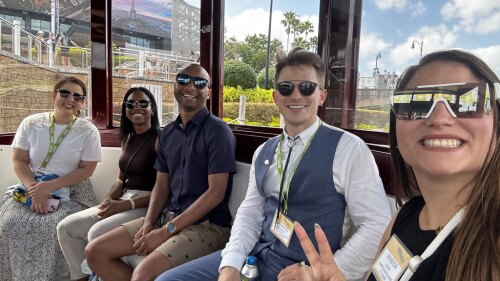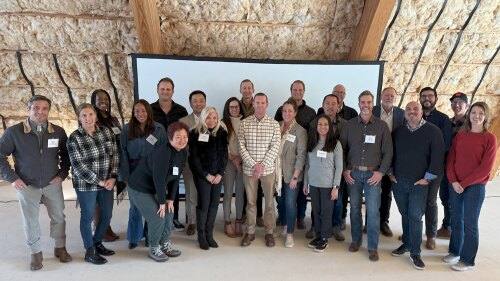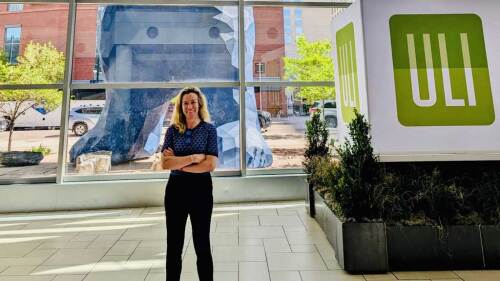In November, ULI announced the appointment of Sarene R. Marshall as the executive director of the ULI Center for Sustainability. Marshall comes to ULI after serving in senior management roles for more than a dozen years at the Nature Conservancy (TNC), a global nonprofit organization with the mission of conserving the land and water on which life depends. Marshall was managing director of the TNC Climate Change program and associate director of the Forests and Climate program. She developed food and water security strategies in Latin America and launched efforts to address sustainability in the organization’s operations through workplace recycling, water, waste, and carbon reduction programs. In addition, she led change management, globalization, and strategic planning projects on behalf of TNC’s executive team.
A graduate of the Wharton School of Business and the Lauder Institute of Management and International Studies at the University of Pennsylvania, Marshall oversees the two programs that comprise the Center for Sustainability—the Greenprint Center for Building Performance and the Urban Resilience Program.
Marshall recently sat down to discuss her role in elevating the Center for Sustainability’s position in the global dialogue on resource use, climate risks, and connections to the built environment, human communities, and cities throughout the world.
ULI’s Center for Sustainability tackles climate risks from two distinct perspectives: first, how property owners can reduce emissions and conserve resources to mitigate climate impacts, and second, how communities can effectively prepare for natural disasters resulting from climate change–induced extreme weather or gradual changes in the environment like rising temperatures and sea-level rise.
How do you see resilience at the community level and greenhouse-gas emissions reductions at the building scale working in tandem to address the impacts of climate change?
On the one hand, we have a set of environmental issues that arise from energy use and resource use at the building level. And when we add all of that up cumulatively, we have the possibility of some pretty unmanageable impacts on the planet and on communities. These two pieces work together, informing different scales of action.
Resource-use efficiencies can help us avoid the unmanageable. A lot of that does happen at the building scale. We’ve been really focused on the building-scale side when it comes to energy and resource use, but one of the biggest energy impacts of a building is where you put it, including the transport energy it takes to get people and goods to and from the building. So, thinking at a bigger scale—beyond the building—is actually important in terms of the full environmental impact.
On the other side, we have resiliency, which is really about managing the unavoidable. We are at a point where a number of things in terms of resource use have built up in the system, and we’re starting to see the impacts of those past actions in the form of increasing temperatures, flooding, and other types of issues that are no longer avoidable.
Here, scaling up is critical because the management of impacts from floods or heat waves is not going to be building-specific, but rather community-wide. There are things you could do on a building scale, but we’re at the earlier stages of understanding this: how can you build for resiliency at the building scale while linking that to community-level action, planning, hazard mitigation, etc.?
Practically speaking, how do you get developers, owners, and occupiers to think beyond their individual property line and to scale up their thinking about resilience?
The example I gave is building siting, planning, and thinking about transit infrastructure, which allow us to build denser, more connected cities that use less energy on a per-capita basis. That’s going up a scale to provide shared services and resources beyond the building.
On the resilience side, we can think about flood-proofing a specific building or building to higher tolerances for hurricane winds, and that’s controlling at the building scale. But questions around whether or not we build in floodplains or what kind of community fabric, services, and infrastructure are available to bring people together when they have to respond to or build back from an event, that is all above the building—which reinforces my point: resource efficiency and resilience work together. On both sides of this issue, we need to think about the connections between individual buildings and the larger, community-scale actions that are really meaningful.
ULI has been engaged with the issues of climate change and urban development for several years through what was previously known as the CLUE [Climate, Land Use, and Energy] initiative. The Center for Sustainability provides an opportunity to expand on this existing body of work. How would you define your role in steering the center and in elevating ULI’s profile as a thought leader on sustainability?
One of the reasons this job was exciting to me is that, as I read ULI’s mission, sustainability is at its core. It’s at the heart of “responsible land use.” And sustainability is essential when you talk about communities being able to thrive, because your resources are sustained and you can thrive in the face of adverse events.
It’s exciting for me to be in this seat at this time when there have been some really great efforts and programs that precede me and give me a strong starting point, including the CLUE program and the two programs that live under the center now.
Clearly, we have great leadership under Helen [Gurfel], the executive director of the Greenprint Center, and Brenden [McEneaney], director of the Urban Resilience Program. My role is to help them think about expanding the impact of their existing programs. Because I come from outside the real estate sector, I have the benefit of different perspectives. I am asking lots of questions and generating some out-of-the-box ideas on how we can really scale up our impact—thinking strategically about our products and offerings, and delivery of those offerings to our members and others in creative ways.
One key element for ULI is connecting with others. The sustainable-city space is a very crowded field, and everyone from academics to NGOs [nongovernmental organizations] have jumped on the bandwagon of creating content around sustainable cities. I think that ULI has to be smart about our resources and smart about how we partner with others, who often have a bigger megaphone than we do or comparative advantage in being able to do certain kinds of research or reach certain kinds of audiences that we can’t.
But what these other organizations don’t have are real estate developers in their ranks. We clearly need to be bringing our unique comparative advantage to this conversation.
I see myself in a shepherding or steering role more than anything. I don’t have the market on good ideas. It’s about getting out there and talking to folks who have those good ideas both inside and outside ULI, and helping make connections while thinking strategically because resources and time are limited.
You mentioned that the sustainability field is a crowded one. How would you define ULI’s niche within broader and ongoing initiatives around climate change and sustainability? What value or perspective do we add to the marketplace of best ideas and practices?
We have the unique and valuable position of being composed of members who have real experience from the front lines. When it comes to sustainable cities, many organizations are trying to target the very people who are our members. We have members who are actually making things work in cities in sustainable ways, or seeing how they don’t work. Those perspectives are essential to informing what some of the barriers are to sustainability in cities. I think we have the unique position of being able to marry the private sector and the public through efforts like the Rose Center for Public Leadership and our partnership with the National League of Cities and our great strength with developers in our ranks. We’re not going to address this issue or others in cities if we don’t bring these two sides together.
We have the depth, topical knowledge, and reputation as an organization that is doing good work with good members and adding value. We have a network through our members, and through all the cities we’ve worked with and in, and reach that a lot of others don’t have. I think we have great assets to bring to the table in terms of making a difference on this issue.
Describe how your experience and the expertise you gained within the Nature Conservancy informs your current position.
When I was going through a job search process, I got connected with Todd Mansfield, ULI’s former chairman, who is also quite active in the Nature Conservancy. He said the two organizations have quite a lot in common, and he is absolutely right. Both organizations are very practical, solution-oriented, non-confrontational, and committed to a big-tent approach, which leads us to be focused on forging alliances with others but also being focused on what works. The former CEO of the Nature Conservancy would say, “We aren’t an organization that says yes or no. We’re the organization that says ‘How?’” ULI is also really about the “how”—how do we make this work?
There are some other interesting parallels between the two organizations. Both are heavily decentralized and really built on a local network of supporters—originally volunteers in TNC’s case and still volunteers in the ULI membership case. I learned over 12½ years at TNC that a lot of the greatest ideas come from people on the front lines, and that creative energy in the field is really critical to harness and leverage for greatest impact. I learned a lot of lessons about partnering well when you sit in the center at headquarters and creating good relationships with those in the field.
From a content perspective, I learned a couple of things that are key to the work I’m doing at ULI. I led the climate program at TNC for several years, so I learned the climate science, but also the practicalities of trying to forge solutions on climate change across a big-tent, global organization with a lot of different perspectives. That’s very similar to ULI. We are also a big-tent organization with a lot of different perspectives.
The other thing I bring is knowledge on green infrastructure. The great news about green infrastructure is that it can be a win-win solution that is both good for the environment but also good for cities, people, and communities. As we move ahead with new models for how to deal with stormwater runoff, how to capture carbon emissions, or how to bring down heat in cities as temperatures rise, the role of green infrastructure is going to be really critical.
How do we balance the need and right for individuals and communities to be prosperous and profit oriented with the more altruistic goal of doing what’s right for the natural environment?
This is a false dichotomy. The right answer for the planet is also the right answer for people and profits in the end. Increasingly, research and practice are demonstrating that the more sustainable approach is also the more profitable approach. It’s very easy to see this connection with energy efficiency. It saves you money. There are increasingly regulatory requirements for energy efficiency, which means you can’t be competitive—your property is not marketable—if you’re not doing the right thing in terms of energy use.
If you look at the long arc of human history, societies, communities, places that don’t respect or care for the natural resources around them typically collapse under their own weight. Whether it’s polluting the river that you’ve built alongside so that river is no longer an asset or it’s the air pollution in Beijing—which is now affecting Beijing’s economy such that the government in China knows they have to do something about it—environmental destruction cannot sustain economic growth
If you look at polling data in the U.S., voters don’t believe there’s a dichotomy between being economically successful and protecting our natural resources. They believe they can have both clean water and protected lands and economic growth, and that they don’t have to choose between these things. Consumers see this, too. What makes for a good city is that people want to live there because it has air you can breathe, water you can drink, and parks you can walk around in. It’s a virtuous cycle.
How do you see the center fully engaging with ULI members to create awareness and generate action and change in implementing some of the best practices of sustainability and resilience?
I’m looking forward to using all the tools in the ULI toolbox to engage and work with members. We’re working on programming for the Fall and Spring Meetings, which provide opportunities for members to learn about different topics in person. We are developing new research products and publications for members, including a business case for investing in resilience. And we’re developing course offerings on sustainability, green building, and Resilience 101 through our education program.
One thing I’m looking forward to is much more creative ways of sharing content—really using 21st-century tools like videos and virtual gatherings—as well as partnering with district councils who touch a lot of members through face-to-face engagement to develop programs locally, or take local programs and share them through our global network.
I’m open to ideas and very much looking forward to folks telling me what would be useful to them. Through their district councils, product councils, or directly, they can let me know what they need to know, would like to learn, and whom they’d like to hear from.
Learn more about the ULI Center for Sustainability’s work.





